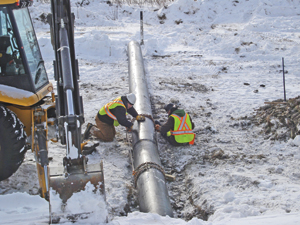Failing Culverts Relined During Canadian Winter
 It is no surprise that weather conditions affect how a pipe rehabilitation project is handled and whether a project is ultimately a success. Before undertaking a project in the winter, it is important to discuss different repair methods and to consider the potential for weather-related project delays. In some instances, when a repair is urgent, there is no choice but to begin a project in less than ideal conditions.
It is no surprise that weather conditions affect how a pipe rehabilitation project is handled and whether a project is ultimately a success. Before undertaking a project in the winter, it is important to discuss different repair methods and to consider the potential for weather-related project delays. In some instances, when a repair is urgent, there is no choice but to begin a project in less than ideal conditions.
In this particular case, the problem involved repairing damaged drainage culverts during a Canadian winter.
Culverts in need of repair pose a risk to the infrastructure of roads, and if they fail, will cause damage and disrupt traffic. Therefore, the Province of Saskatchewan Ministry of Highways and Infrastructure in Canada decided to review the condition of their culverts. It costs less to repair a culvert before it fails than to replace it after it has already failed. The costs of culvert failure are not only monetary, but also refer to social costs such as lengthy traffic diversion, road closures and concern for public safety.
The Ministry has several culverts in its inventory that provide essential drainage and water control in its regional highway network. After investigating these culverts in fall 2009, a number of them were discovered as damaged or failing. These damaged or failing culverts were nearing or past their design life. Some also needed immediate attention, which would mean replacing them in winter. To manage and repair the culverts, the Ministry explored cost-effective ways to rehabilitate them while avoiding the use of a dig-and-replace method, which would be difficult and cumbersome in the winter and cause traffic delays. The Ministry also wanted to avoid the hammering and jacking of steel liners.
By acting proactively, the Ministry rehabilitated three failing corrugated metal culverts successfully in the winter using a pipe relining method. This was the first time this pipe relining method was used in the Province of Saskatchewan.
Weather Cycle Concern
The Ministry had two goals in mind for repairing the culverts. First, there was a focus on cost-savings. Secondly, the method of repair had to fit into the Saskatchewan weather cycle. Saskatchewan has a relatively short spring and summer. Spring is wet and short with high levels of runoff. Mild spring conditions usually do not start until April. Summer can also have wet conditions, specifically around culverts. The fall is arid so most culvert inspections occur at that time.
However, when a culvert is inspected in the late fall, but is considered to be at a risk of failure, it is not possible to wait until summer or the following fall to repair it. It has to be handled as soon as possible to avoid the costs of failure. Therefore, the Ministry decided that some repairs had to take place in winter. This is a problem when considering some methods of repair as the temperatures in the winter average between 20 and 30 F.
Conventional methods such as excavating and reinstalling culverts were not a feasible possibility, especially with temperatures remaining below freezing for most of the winter. For this reason, the Ministry decided to look into culvert relining methods, specifically choosing the culverts in need of repair that could not wait for the spring thaw. This decision resulted in a pilot project to fix three failing corrugated metal 24-in. culverts that needed immediate repair. They were inspected in the fall after being cleaned out, showing signs of corrosion. Each culvert was approximately 135 ft long.
Reline Method Chosen
PSI Technologies, a Snap-Tite pipe distributor, and Mark Theetge, a Snap-Tite representative, introduced the Ministry to the Snap-Tite system of relining culverts. With the Ministry’s approval, PSI Technologies vice president of business development Brian Taylor, P.E., arranged for a local demonstration project involving the three failing culverts using this relining method.
PSI Technologies also served as the contractor on this project. It was decided that each 24-in. culvert would be relined with 20-in. high-density polyethylene (HDPE) Snap-Tite pipe. Despite the reduced diameter of the HDPE pipe used to reline the old 24-in. pipe, the flow rate will likely increase due to the pipe’s smooth wall interior.
Unlike most HDPE pipe installations, Snap-Tite HDPE pipe does not require a butt fusion process to join the pipe pieces together. Instead each pipe end is machined in a kind of “snap” joint. Furthermore, because the pipe is joined and slid into old culverts on site, installing it does not cause traffic disruptions. Also, it can be installed in the winter, outside of the regular construction season.
Installation
The project was approved by the Ministry and the installation began in February 2010. To start the installation process, the culverts were cleaned out of any dirt or debris using heated water from a hydro-vac truck. Some of the old culverts had damaged ends and so these were trimmed down to allow the liner to be inserted. Once the ends were trimmed, a section of the new pipe liner was partly slid inside each old failing culvert. The Snap-Tite pipe end has either a “female” or “male” end where the joint is snapped together. This requires only minimal equipment such as a backhoe, shovels, a come-along (lever chain puller) and chains.
Once one of the sections of new pipe was slid partially into the old pipe, the “male” joint end of the pipe was connected to the “female” end of the preceding pipe section, creating a water-tight joint. Then, as each joined section of pipe was slid further inside the culvert a new section was attached using the same method. The process continued for all three culverts until each one was completely relined with the new pipe. The liner ends were also trimmed as needed.
Finally, the space between the old culverts and the new pipe liners was grouted, filling in any gaps that might be present due to the level of damage in the old culvert. The grout used in this application was cellular concrete, which was made of cement, water, foam, sand and air. This type of grout is often used in cold temperatures because of its ability to generate heat within itself.
 The grout and Snap-Tite HDPE pipe liner worked well in the Western Canadian climatic conditions, especially since the installation was rather quick; much quicker than having to dig and replace the culverts. The pipe lining project began and was completed within a month.
The grout and Snap-Tite HDPE pipe liner worked well in the Western Canadian climatic conditions, especially since the installation was rather quick; much quicker than having to dig and replace the culverts. The pipe lining project began and was completed within a month.
In the end, both goals of this project were realized. First, the cost-savings. This reline method cost the Ministry approximately 40 percent less than traditional dig-and-replace methods. Secondly, the culverts were repaired in the winter, which would not have been possible with an excavation and replacement method.
The Ministry also plans on future culvert reline projects due to the success of these three installations. PSI Technologies will also work with the Ministry to evaluate ways of diagnosing culvert failure using ground penetration radar and Falling Weight Deflection Testing equipment.
“The Ministry wants to reline additional culverts in the summer and evaluate non-destructive methods of evaluating culverts,” said Taylor. “As these methods prove successful, they will institute them into the Standard Road Design standards for the Province.”
Joanna Climer is a public relations specialist with ISCO Industries, Louisville, Ky.




